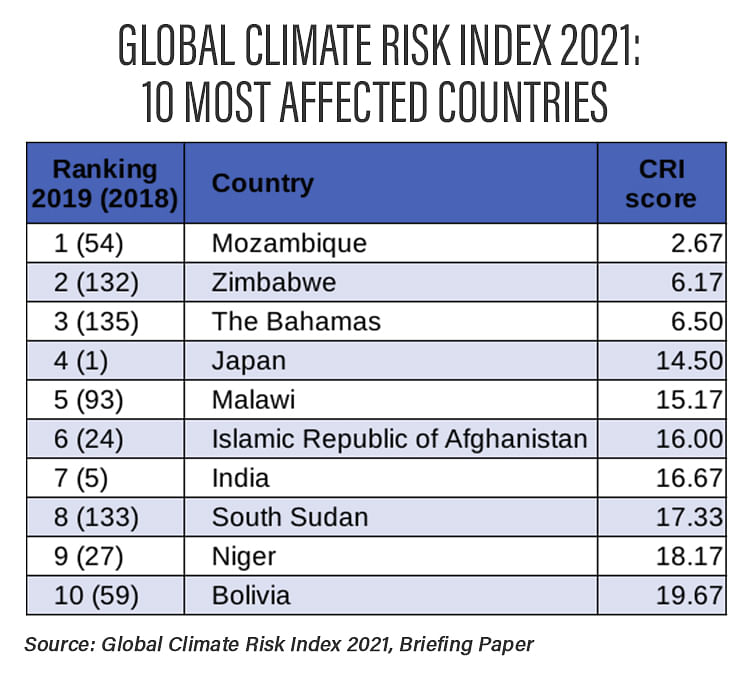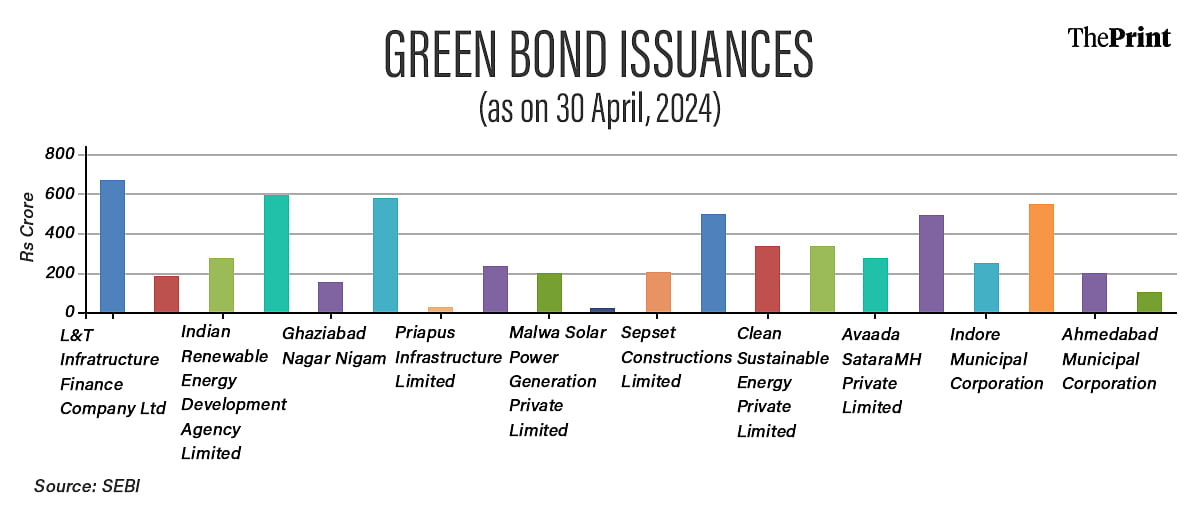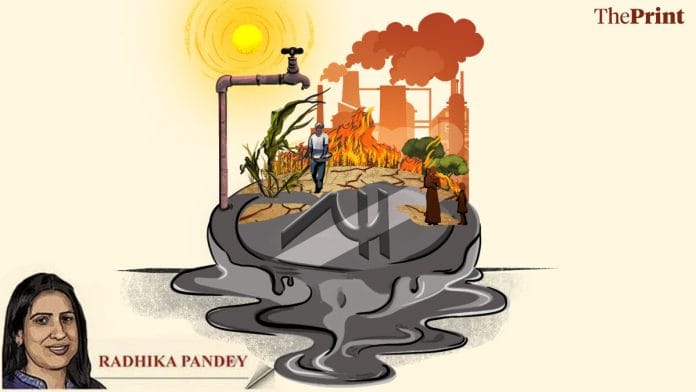Countries world over are grappling with the impact of record-breaking extreme weather events. Globally, climate change adaptation policy measures and financial resources are falling short of the scale and intensity of climate related events. The country’s rapid economic growth with fast-paced industrialisation and urbanisation is putting a strain on its natural resources. Extreme weather events are further exacerbating the stress on resources.
India’s vulnerability to climate risk
India is highly vulnerable to extreme climate events due to its unique geographical features. The Global Climate Risk Index developed by Germanwatch indicates the countries’ level of exposure and vulnerability to extreme events. The latest ranking pertains to 2019. The report places India seventh in the list of countries most affected by climate change. Mozambique, Zimbabwe and the Bahamas were the most affected countries.

According to the World Risk Index 2023, developed as part of the World Risk Report, India ranked third amongst 193 countries with the highest disaster risk worldwide. The index is based on the interaction between exposure and vulnerability.
There are studies assessing the climate risk vulnerability of Indian states and districts. The national climate vulnerability assessment report by the Department of Science and Technology identified Jharkhand, Mizoram, Odisha, Chhattisgarh, Assam, Bihar, Arunachal Pradesh, and West Bengal as states highly vulnerable to climate change.
An analysis by the Council on Energy, Environment and Water (CEEW) has developed a climate vulnerability index for Indian states and UTs based on exposure, sensitivity and adaptive capacity. According to the vulnerability index, Assam, Andhra Pradesh, Maharashtra, Karnataka and Bihar are the five most climate-vulnerable states in India. Assessment of vulnerability is an essential first step towards designing adaptation intervention by states.
Also read: Shrinking gap between average rural & urban consumption spends good news, but inequality persists
Impact of climate change
The impact of climate change spans across multiple sectors. Various estimates have pegged the loss to Indian GDP due to climate change between 3 to 10 percent. A recent report by Moody’s has even warned that acute water shortage could negatively impact India’s sovereign credit rating.
Decrease in water supply can disrupt agricultural production, leading to a rise in food inflation and decline in income. This could trigger social unrest and undermine the economy’s ability to withstand shocks. Disruptions in agricultural production and food inflation could necessitate higher food subsidies that could disturb India’s fiscal math.
Another sobering report shows that over 50 percent of marginal farmers were affected by natural calamities in the past five years. Due to climate change, a substantial 42.6 percent of the marginal farmers harvested half of what they had expected to do in a normal year. The survey report indicated that farmers with the least landholding between (0-0.5 acres of land) experienced the highest loss in crops compared to other categories. These farmers were forced to work as wage labourers to overcome some of their losses.
Another channel through which climate change impacts agriculture is through labour productivity losses due to high temperatures. Construction and industrial sectors are also prone to labour productivity losses due to excess heat.
Acceleration of climate change has strained water supply. Among industrial sectors, coal power generators and steel-makers are most vulnerable to water shortage as they depend heavily on water for production. Thermal coal power plants can face disruptions during episodes of drought and water shortage. Steel makers are also significant consumers of water as the existing steel production technology is highly water intensive.
Stepping up climate resilience
There needs to be a well-crafted strategy to make agriculture more resilient to climate change. Work is required on multiple fronts spanning mitigation and adaptation strategies. Government needs to focus on climate resilient varieties of seeds that require investments in agriculture research and development. More investments are needed in irrigation facilities and towards efficient water storage. Incentive frameworks could be considered to incentivise farmers to shift from water intensive crops to less intensive ones. Government also needs to invest in mitigation strategies including developing robust early warning systems for extreme events.
Need for low-cost public climate finance
For India, an estimated USD 10 trillion is needed to scale up climate transition and achieve net-zero emissions by 2070. However, estimates suggest that only USD 44 billion have been raised for climate finance. As a result, there is a substantial climate finance gap.
There is a need for low-cost, long-term finance for climate vulnerable economies like India. In 2009, developed countries committed to provide an annual USD 100 billion by 2020 to support climate action needs of developing economies.
Even in 2021, the amount provided by developed economies was USD 89.6 billion. Bulk of it was for mitigation rather than for adaptation. India has called for at least USD 1 trillion per year from developed to developing countries, underscoring need for grants and concessional finance. In this context, climate negotiations regarding the New Collective Quantified Goal (NCQG) (replacing the USD 100 billion goal) at the upcoming UN COP29 will be crucial in determining the quantum and kind of future climate finance support.
Need for mobilising private capital for climate action
Public finance alone cannot meet the total climate finance requirements. There is a significant need to mobilise private finance for climate action. At the domestic level, introduction of Sovereign Green Bonds (2022) and Green Deposit Framework (2023), that place the government and banks as key facilitators, respectively, are positive steps towards developing the green finance ecosystem in India. However, the risk-return profiles of the climate/green projects may not be amenable to private capital at scale. The first sovereign bond auction of the current year did not go through because the market sought yields that were at higher levels than the government and RBI were comfortable with.
At a sub-sovereign level, interventions should focus on deepening the Indian municipal green bond market. A total of Rs 6,128 crore has been raised through green debt securities since 2017, including issuances by municipal bodies amounting to Rs 694 crore since 2021. Municipal bonds can provide the much-needed finance for local climate action needs, aligned with State-level Action Plans on Climate Change (SAPCCs). For e.g. Vadodara Municipal Corporation raised Rs 100 crore in March 2024 by issuing Asia’s first certified green municipal bond to support the city’s liquid wastewater management infrastructure. There is also a need to strengthen disclosure requirements and eligibility criteria to better align them with global green finance guidelines.

Radhika Pandey is associate professor and Anandita Gupta is a research fellow at National Institute of Public Finance and Policy (NIPFP).
Views are personal.
Also read: GST regime needs transformation. Rate rationalisation, simplification must be council’s key priority






